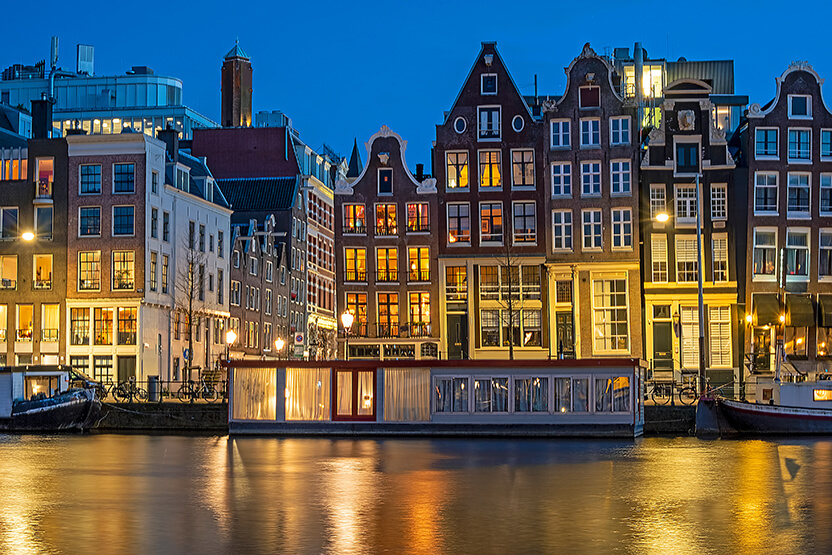Tips when buying a houseboat
The Dream of Living on the Water
Living on a houseboat offers a unique lifestyle, whether you choose the tranquility of the water or the dynamics of the city. But before you dive into this adventure, it is important to consider several aspects.
Different Types of Floating Homes
There are various types of floating homes:
Houseboats : Traditionally these were converted ships that were adapted for habitation. They often retain their characteristic ship appearance and can sometimes still sail.
Houseboats : These resemble houseboats but are often larger and more luxurious. They are intended for permanent residence and are usually no longer seaworthy.
Houseboats : These are floating houses without their own propulsion, built on a floating pontoon made of concrete or steel. They are usually spacious and modern, with all the comforts of a traditional home.
- Schark : A mostly metal ship, often a disused inland vessel or barge, on which a wooden, stone or plastic superstructure has been made. It resembles an ark, but is distinguished by its often metal substructure.
Water villas : These are similar to houseboats but are often more luxurious and architecturally advanced. They often offer high-end amenities and design.
Water homes : These are essentially houseboats or water villas that are specifically designed to integrate into a water-rich environment, often with special attention to environmental aspects.
Each type of floating home has specific characteristics that distinguish it in terms of maintenance, stability, living comfort and regulations regarding moorings:
Maintenance : Houseboats and houseboats often require more maintenance than houseboats or water villas. Steel ships in particular require regular maintenance to prevent rust. Houseboats and water villas, especially those with a concrete shell, require less maintenance and are generally more durable.
Stability : Houseboats and water villas generally offer more stability than traditional houseboats or houseboats. This is due to their wide, flat floating foundations that allow for less movement on the water.
Living comfort : Water villas and modern water homes often offer a higher level of living comfort, with modern amenities and more spacious living areas. Traditional houseboats and houseboats can be more limited in terms of space and modern conveniences.
Regulations regarding moorings : The regulations for moorings can vary greatly per location and type of floating home. Some areas may have restrictions on the type of floating homes allowed or require specific permits, especially in urban or environmentally sensitive areas.
These characteristics influence the choice of a specific type of floating home, depending on personal preferences, budget and the desired lifestyle.
Financial Aspects
Costs and Mortgages
Purchasing a houseboat, with prices ranging from €100,000 excluding mooring to (at least) €350,000 inclusive, is often cheaper than a house. However, the costs are not limited to the purchase alone. Insurance costs are usually higher due to risks such as sinking. Maintenance costs can also be significant, especially on older or steel/wooden houseboats. For financing, options are limited to a few banks, such as Rabobank and Triodos Bank, which specialize in houseboat mortgages.
Mooring costs
The costs for a berth, especially in the Randstad, can range from €200,000 to at least €700,000, often the largest financial consideration. The reasons for these high costs include:
- Location : In popular areas such as Amsterdam, where space is limited, mooring prices are higher.
- Supply and Demand : Demand for moorings often exceeds supply, driving up prices.
- Permits : Obtaining the necessary permits for a mooring can be a complex and expensive process.
- Facilities and Accessibility : Moorings with good facilities such as electricity, water and good accessibility are more expensive.
Given these costs, it is important to plan a detailed budget when considering purchasing a houseboat, especially in the Randstad.

Maintenance and Safety
Regular Maintenance
Maintenance varies per type of houseboat. For example, steel ships require a steel thickness check every 5 years, while houseboats with a concrete box have comparable maintenance needs to a traditional house.
Safety Standards and Regulations
Houseboats must meet certain safety standards and legal requirements, such as fire safety and connections to utilities. Regulations may vary by location, so it is important to check these when purchasing or moving.
Permits and Regulations
Necessary Permits
A mooring permit is required for each houseboat. In addition, an environmental permit has been required for construction plans since 2018. Depending on the location, a water permit may also be necessary. In some cases a specific fire safety permit is required.
Lifestyle and Amenities
Choosing the Right Lifestyle
Think carefully about the lifestyle you want to live and the amenities you need. Some houseboats are self-sufficient with water purification and energy generation systems, while others rely on land-based facilities.
Conclusion: Good Preparation is Half the Work
The Role of the Purchasing Agent
When purchasing a houseboat, a specialized purchasing agent can be of great value. By considering these aspects in advance, you are well prepared for the unique and beautiful life on the water.
Hopefully this information has helped you make an informed choice and ultimately ensure that you can enjoy the special life on a houseboat.
